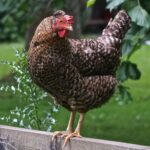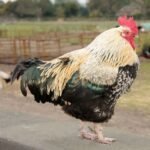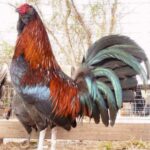Most hens will lay their first egg around 18 weeks of age. It’s best practice to start your chickens on a layer feed when they’re either 18 weeks old or when they lay their first egg - whichever comes first.
Good nutrition is important to the health and wellbeing of chickens, and Layer feed is specially formulated to provide all of the important nutrition hens need to lay eggs at their best.
It’s been scientifically proven to help hens produce better, healthier eggs. So, it’s within both you and your chicken’s best interests to feed them a good layer feed.
Table of Contents
Why Do Chickens Need a Layer Feed?
In short; producing eggs on an (almost) daily basis takes a lot of good nutrition, the right environmental conditions, and a lot of effort on the chicken’s part!
It’s nothing short of a miracle if you think about it. As backyard chickens primarily eat the feed you provide, it’s no surprise that a hen needs good quality feed to lay good quality eggs.
Layer feeds vary in their exact nutritional content, but typically they contain 16% protein and anywhere between 3-4.5% calcium.
Protein is important to chickens for growing strong feathers, nails, producing eggs, and maintaining good health.
Chicks start out on a feed containing 18-20% protein, are often dropped to a 16-18% grower feed, then moved on to a 16% layer feed when they start laying.
The calcium content is important as eggshells are made almost entirely from calcium carbonate. So much so that chickens need at least 4 grams of protein per day to create an eggshell.
If a chicken is not getting enough calcium, it will either pull the calcium from elsewhere in its body, such as from bone development, or they’ll lay improperly formed eggs.
How to Transition Your Hens Onto a Layer Feed
It’s not difficult to switch chickens over from a starter feed to a layer. You should do it gradually to help prevent any digestive upset though.
Just simply start mixing some layer feed into their starter, grower, or whatever feed they’re currently eating and they’ll be done the wiser.
3-4 weeks of gradually mixing feeds before swapping over completely should be more than long enough.
It’s also good practice to have a set feeding routine for chickens, especially laying hens. Ideally, you should put out some feed in the morning, and again in the evening.
Try to ensure that their feed is making up at least 90% of their diet, too. This isn’t usually too difficult. Hens will forage and find a few bugs here and there, but unless you’re giving them treats they’ll rely on eating feed.
Related - How often should you feed backyard chickens?
What Is the Best Layer Feed for Chickens?
There are a number of great brands of chicken feed on the market that will provide your chickens with all the nutrition they need.
For a lot of people, it comes down to personal preference which layer feed they use. Their choice is usually based on other owner reviews, recommendations, or maybe the price is a factor, etc.
I can give you an example of two of the best layer feeds on the market according to popular opinion. These are both available on Amazon, and are:
Purina Layena Complete Layer Feed
Promising rich yellow yolks and delivering all the good nutrition laying hens need is this feed from Purina.
It’s 16% protein, formulated with prebiotics, and contains oyster shells to provide a more diverse range of calcium.
You can check the latest price and availability on Amazon via the links below if you’re interested:

Click here to see thsi Purina Layena Complete Layer Feed on Amazon!
Manna Pro Organic Layer Pellets
If it’s important to feed your chickens organic feed, this feed from Manna Pro is 100% USDA certified organic and 100% non-GMO.
It’s also 16% protein, as this is the optimal amount of protein for laying hens. It contains a wide range of vitamins and minerals and comes in a pellet form.
You can check the latest price and availability on Amazon via the links below if you’re interested:

Click here to see thsi Purina Layena Complete Layer Feed on Amazon!
Related Questions
Can 3-Month-Old Chickens Eat Layer Feed?
It’s not advisable to give 3-month-old chickens layer feed. When chickens are just 12 weeks old, they require a very different nutritional intake than 18-week old chickens that are laying eggs.
12-week old chickens should be eating a starter or grower feed that has 16-18% protein. They need this extra protein to promote healthy bone and feather development.
Can 16 Week Old Chickens Eat Layer Feed?
16 weeks is the earliest you should be switching your hens over to a layer feed. Or, at the very least be in the process of mixing some layer feed into their diet to transition them onto a layer.
Unless they have laid their first egg, of course. Starting to lay at 16 weeks is rare, but not unheard of.
Some breeds do mature faster than others. If a hen is laying eggs you need to get them on a layer feed to ensure they’re getting all the nutrition they need.
At What Age Do Chickens Begin Laying?
There are a number of factors that contribute to the age at which a hen will lay its first egg. Generally speaking, however, most hens will lay their first egg between 18-22 weeks of age.
The breed of the chicken is probably the biggest factor. Some breeds mature a lot quicker than others, just as some breeds lay far more eggs than others.
Don’t panic if you’ve passed the 22-week mark and not had your first pullet egg yet. It’s likely you have a slow maturing breed or a late bloomer on your hands.
Keep an eye out in that nesting box, you’ll see an egg in there before too long!
Related - Here’s a look at when Dominique and Brahma chickens start laying.
Which Is Better for Chickens Pellets or Crumbles?
Chicken feed comes in various types; such as pellets, crumble, mash, and scratch. I’d say the two most popular options are pellets and crumble though.
If you’re trying to decide between these two types, it’s a close call. I’d say the main differences are that crumble is easier for younger chickens to eat, but it does make more mess.
A lot of owners prefer pellets because they make less mess, and you can be a little more certain that your chickens are getting a good balance of nutrition as they’re swallowing whole pieces.
It’s really up to you though, there’s no difference from a nutritional standpoint as long as your chickens are eating the feed you provide.
In Summary
You should start transitioning your hens over to a layer feed around the 16-18 week mark. It’s important that they’re eating layer feed as close to when they are point-of-lay as possible.
Laying hens need good-quality nutrition to maintain optimal health and lay at their best. There is no better way to ensure your hens are getting a good balance of all the nutrition they need than by providing a quality layer feed.
Resources
Image credits - Photo by Brett Jordan on Unsplash




